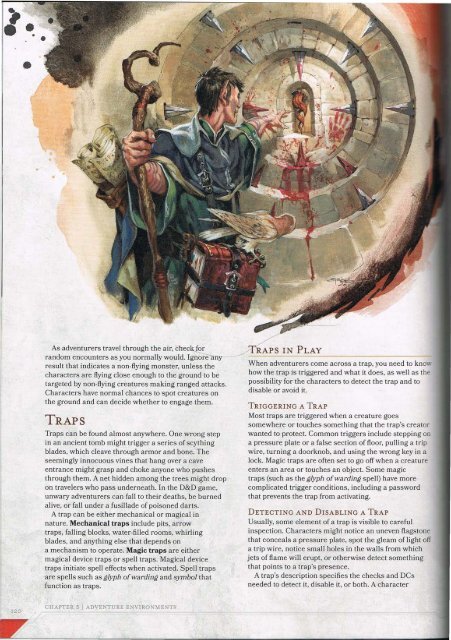Dungeon Master's Guide
You also want an ePaper? Increase the reach of your titles
YUMPU automatically turns print PDFs into web optimized ePapers that Google loves.
•<br />
•<br />
• •<br />
As adventurers travel through the air,<br />
random encounters as you normally would. lgnore -.,...,,~-<br />
result that indicates a non-flying monster, unless the<br />
characters are flying close enough to the ground to be<br />
targeted by non-flying creatures making ranged attacks.<br />
Characters have normal chances to spot creatures on<br />
the ground and can decide whether to engage them.<br />
TRAPS<br />
Traps can be found almost anywhere. One wrong step<br />
in an ancient tomb might trigger a series of scything<br />
blades, which cleave through armor and bone. The<br />
seemingly innocuous vines that hang over a cave<br />
entrance might grasp and choke anyone who pushes<br />
through them. A net hidden among the trees might drop<br />
on travelers who pass underneath. In the D&D game,<br />
unwary adventurers can fall to their deaths, be burned<br />
alive, or fall under a fusillade of poisoned darts.<br />
A trap can be either mechanical or magical in<br />
nature. Mechanical traps include pits, arrow<br />
traps, falling blocks, water-filled rooms, whirling<br />
blades, and anything else that depends on<br />
a mechanism to operate. Magic traps are either<br />
magical device traps or spell traps. Magical device<br />
traps initiate spell effects when activated. Spell traps<br />
are spells such as glyph of warding and symbol that<br />
function as traps.<br />
SIN PLAY<br />
When adventurers come across a trap, you need to know<br />
how the trap is triggered and what it does, as well as the<br />
possibility for the characters to detect the trap and to<br />
disable or avoid it.<br />
TRIGGERING A TRAP<br />
Most traps are triggered when a creature goes<br />
somewhere or touches something that the trap's creator<br />
wanted to protect. Common triggers include stepping on<br />
a pressure plate or a false section of floor, pulling a trip<br />
wire, turning a doorknob, and using the wrong key in a<br />
lock. Magic traps are often set to go off when a creature<br />
enters an area or touches an object. Some magic<br />
traps (such as the glyph of warding spell) have more<br />
complicated trigger conditions, including a password<br />
that prevents the trap from activating.<br />
DETECTING AND DISABLING A TRAP<br />
Usually, some element of a trap is visible to careful<br />
inspection. Characters might notice an uneven flagstone<br />
that conceals a pressure plate, spot the gleam of light off<br />
a trip wire, notice small holes in the walls from which<br />
jets of flame will erupt, or otherwise detect something<br />
that points to a trap's presence.<br />
A trap's description specifies the checks and DCs<br />
needed to detect it, disable it, or both. A character<br />
CHAPTER 5 I ADVENTURE ENVIRONMENTS




